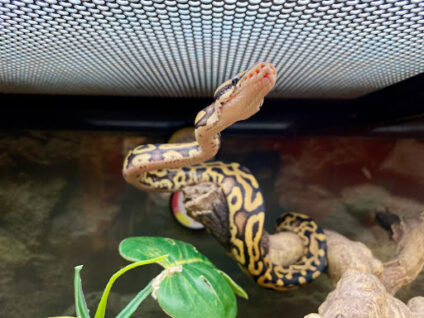Of course, moving cats and dogs is one thing. But what about aquarium animals? These critters require even more preparation and planning to make sure they’re moved safely. Fortunately, these directions can help ensure your scaly, swimmy, and/or creepy crawly friends make it to their new home safe and sound. Read on for your complete guide to moving fish and other tank-dwelling pets.

How to Move with Fish
Fish and other aquatic animals can be particularly sensitive to changes in their environment. So, you’ll need to work carefully to move both your pets and their tanks carefully and ensure they acclimate to their new environment properly.
Preparing Fish for a Move
To move the fish themselves, you’ll need to follow some specific steps to make sure they’re transitioned safely. First, stop feeding your fish 1-2 days before moving day. This will help ensure their water stays clean during the move.
On the day of your move, fill plastic baggies or buckets with water from their tank. For moves longer than an hour or two, you should use a portable air pump to ensure adequate oxygenation. If you’re transporting your fish in buckets, ensure they are thoroughly cleaned and no harsh chemicals that could harm your fish have been used on them.
Moving Fish
Once it’s time to relocate your fish to their new home, move them into their transport containers. If you have multiple fish, put no more than 3 or 4 individuals of the same species in each container. To avoid spillage, put a lid on all buckets (you can improvise here if your bucket didn’t come with one).
Remember, always move your fish in your vehicle with you and never in a moving truck or anywhere far from you. This way, you can ensure their enclosures aren’t disrupted. You can also check your pets’ condition at any time.
Finally, once you’ve set your tank up again after your move, and made sure all its levels are appropriate, you can add your fish back in their tank(s). If you transported them in buckets, carefully scoop them out with a net and place them back in their tank. If you transported them in baggies, first place the bags in the water with your fish inside them so they can get acclimated to the temperature of the new water.

How to Move a Fish Tank to a New House Safely
Moving a fish tank also requires a lot of thought and preparation.
First, before your moving day, make sure you have everything necessary to pack up your tank safely. This might include:
- A net
- A few large buckets
- Plastic baggies
- Bubble wrap
- Packing paper
Packing an Aquarium Tank for a Move
After removing your fish from the tank, unplug it and remove all rocks, plants, substrate and decor. Clean and pack these items separately. Remove and clean all filters, lights, pumps and heaters. Keep your filter media damp and pack it carefully in a sealed container. Do NOT clean the filter media, otherwise you will lose its beneficial bacteria.
Next, drain the rest of the water. You can dump it out in a sink or use a hose to empty larger tanks. Take this opportunity to clean your tank well, particularly those hard-to-reach corners. Then, pack it with the appropriate supplies to ensure its safe relocation.
How to Transport an Aquarium Tank
The best way to move a fish tank is to transport it in your vehicle with you. This will ensure it doesn’t get damaged or thrown around, as tanks are notoriously fragile.
Once you’ve arrived at your new home, set the tank up immediately. Before adding your fish back in, make sure the pH, temperature, chlorine and/or ammonia levels are normal. Especially for longer moves, getting everything rebalanced might take some time. Use air pumps and heaters to keep conditions appropriate in your animals’ transport containers until they can be safely moved back into their tank.

How to Move with Turtles
Of course, it’s not just fish that live in tanks. Another type of animal that can be tricky to transport is turtles. For an aquatic turtle tank, you can follow the same steps when transporting a fish tank (see above). However, preparing your actual turtle for the move is a different process than the one used for fish.
Preparing Turtles for a Move
In the weeks before your move, acquire a portable reptile terrarium or carrier that has plenty of ventilation. Get a size that gives you easy access to your pet throughout the trip but isn’t so big that they’ll risk flipping over.
Next, acclimate your turtle to the car and their carrier. Start by putting them in their carrier in your home for short periods. Then, gradually start taking them on short drives or on errands. By getting them used to travel, your turtle will be less stressed during the move itself. Also, make sure you keep a spray bottle of water with you for both your test runs and the move itself to help keep your turtle damp during the move.
Moving Turtles
On the day of the move, add some familiar items to your turtle’s carrier to make sure they’re as comfortable as possible. This might be their favorite rocks or other accessories from their tank. However, do not include anything large or heavy enough that it could harm your turtle if it shifted during the move. Make sure the items you add to the portable carrier are wet but don’t put too much water in. You want your turtle to have access to water, but not so much that they accidentally drown.
Next, move your turtle to its portable carrier. Prepare a place in your car that’s appropriately warm and out of direct sunlight for them. Additionally, ensure the terrarium is well-braced so it can’t be jostled or knocked over.
Consider having a thermometer handy to make sure your turtle’s environment isn’t overly hot or cold. Keep air vents turned away from the terrarium to avoid having air blowing directly on them. If you’re moving long-distance, consider having a blanket handy to cover your turtle’s enclosure to mimic their regular day/night cycle. If you’re staying in a hotel, you can also bring their tank lights and set them up during the night. That way, you can keep your turtle covered and in the dark during the day.
Set up your turtle’s tank immediately when you arrive at your destination. Make sure you’ve cleaned everything beforehand so you can place your turtle back in their environment as soon as possible. Once they’ve been added to their tank, monitor them closely for the next few hours to ensure everything is working properly and your turtle is acclimating.

What About Terrarium Animals (Lizards, Snakes, etc.?)
Moving a terrarium and its inhabitants requires very similar considerations as moving an aquatic turtle and its tank. Of course, the fact that you don’t need to worry about water does make things a bit easier. First, do some research on the specific conditions your terrarium pet requires to feel comfortable, specifically:
- Temperature range
- Humidity range
- Day/night preferences
During the move, plan your equipment accordingly so you can keep them as close to their comfortable range as possible. This may include:
- Bringing their heating elements into the hotel with you on longer relocations.
- Covering their transport container during daylight hours.
- Using a spray bottle to keep their transport container’s humidity up.
- Utilizing a thermometer to take readings and adjust the heat accordingly.
For moving their enclosure, you can follow the same general steps we outlined above for moving an aquarium tank.
A Good Moving Plan Can Protect Your Pets
Moving with pets can be nerve-wracking. But with the right planning, you can ensure that your pet’s relocation is as safe and comfortable.
Contact Bekins Van Lines for a free estimate on your move, including handling and moving special aquarium equipment. While you focus on the safety and security of your pets’ transition, we’ll focus on yours!


